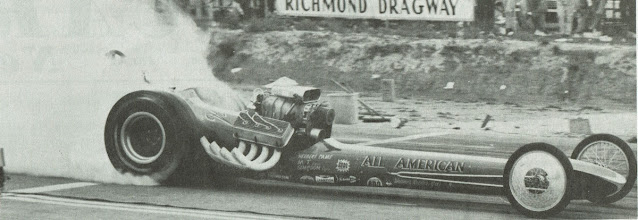 |
| Image of Val LePorte's All-American Dragster from NASCAR Newsletter for June 15, 1966 |
Years of Competition: 1966-1967
Notable Drivers: Dan Smoker, Connie Kalitta, Chris Karamesines, Richard Petty
NASCAR was often associated as a sport where turning left is common with the occasional road courses break that monotony of traditional stock car racing. As hard as it is for many of us to envision NASCAR competitions where the turn of a steering wheel wasn’t required, straight line racing was part of the foundation of the sanctioning body. When Daytona Speed Week was held on the beach/road course, time trials and flying mile races were officiated by NASCAR.
During Speed Week in the late 1950s, drag races took place at Flagler Airport in Bunnell, Florida under the NASCAR banner. In 1960, NASCAR partnered with the NHRA (National Hot Rod Association) to co-host a drag race named the Winter Nationals. On February 13th of 1960, Lewis Carden won the Top Eliminator competition in the joint NASCAR/NHRA event. This alliance between the stock car racing sanctioning body and the drag racing organization was short-lived as allegedly the ambitious founders of their respective groups Bill France Sr. and Wally Parks didn’t enjoy a comfortable working relationship. NHRA’s Winternationals settled in Ponoma, California the year following their joint venture with NASCAR becoming a staple for the drag racing season.
Through the 1960s, NASCAR organized their own drag racing program with regional divisions covering areas across the United States and Canada. East Coast, Mid-West, Northern, Southern and West Coast divisions would host a wide variety of vehicles from dragsters, Altered Coupes as well as street cars in stock and custom trim. One of the requirements in the drag racing division’s rule book was a requirement that only publicly available gasoline with no additives allowed.
 |
| Image of cover for 1966 NASCAR Drag Racing Division Rule Book |
NASCAR increased their profile in drag racing in 1966 by staging a series of international meets for a national championship. A total of six championship events were held with Fueler Circuit and Grand Stock Circuit categories competing for a season-ending title. The NASCAR Drag Racing championship series was headed by National Field Director Walt Mentzer who was also instrumental in the formation of the AHRA (American Hot Rod Association) under the guidance of NASCAR vice president Ed Otto. In 1966, Joe Jacono claimed the Fueler Circuit championship and Melvin Yow took honours for the Grand Stock Circuit. Ron Rivero would be the champion of the Fueler Circuit in 1967 while Dan Smoker took the crown in the Grand Stock Circuit. NASCAR Drag Racing division would fold after the 1967 season.
Despite its short run, the NASCAR Drag Racing championship series lasted long enough to make a contribution to the sport’s history. Within a one-month span at the start of 1967 (between January 29th and February 19th), a young Connie Kalitta secured final round victories in an NHRA, AHRA and NASCAR top fuel event.
 |
| Image from 1965 NATAC Daytona Beach Winter Nationals Drag Racing Program of Richard Petty's 43/JR Plymouth Barracuda |
An NASCAR drag race was also one of the last occasions where NASCAR Grand National/ Cup Series legend Richard Petty would compete in a major straightline battle. In 1965, Petty competed in a number of drag racing competitions across several sanctioning bodies. The King of stock car racing even has a final round victory in NHRA competition. Driving a 43/JR Plymouth Barracuda, Petty win the B/Altered Coupe category at the 1965 Springnationals at Bristol Motor Speedway. On February 27th of 1966, a match race final was held at DeLand Airport between Richard Petty and fellow stock car driver Fred Lorenzen. In the quarter-mile bout, Mopar’s greatest driver lost to the fantastic blue oval competitor as Lorenzen’s Ford Mustang won.
Since the late 1960s, NASCAR largely maintained a strict stock car racing mandate while the NHRA has grown to be a respected body for drag racing. Clearly, there can be moments where it proves best to stay in your own lane.
References:
High Performance: The Culture and Technology of Drag Racing 1950-2000 by Robert C. Post
Super stock : Drag Racing the Family Sedan by Larry Davis
1965 NASCAR Drag Racing Division Rule Book
1966 NASCAR Drag Racing Division Rule Book
ultimateracinghistory.com

No comments:
Post a Comment